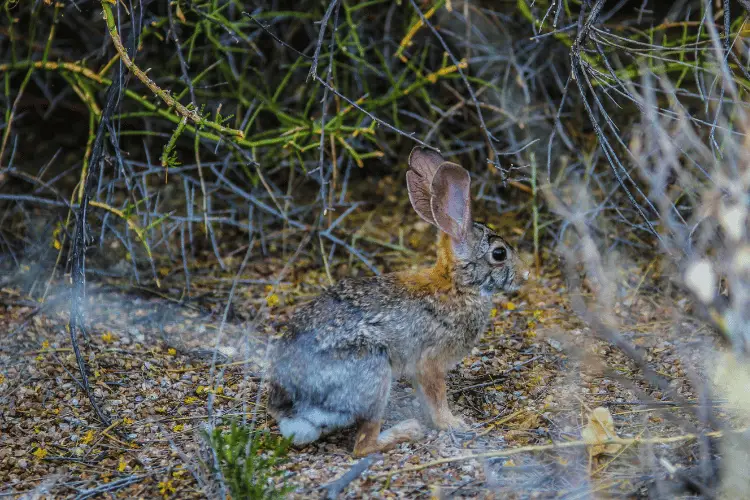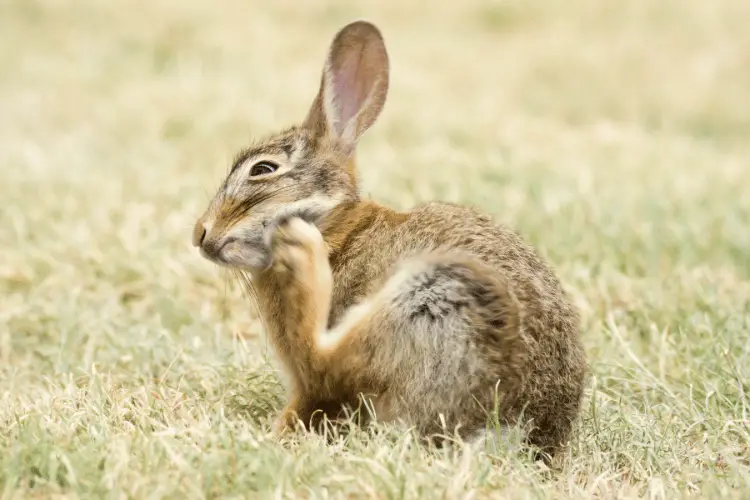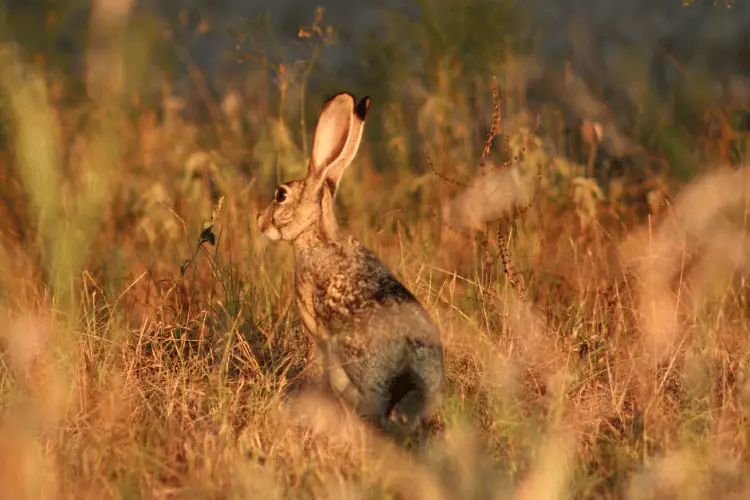We strive to provide you with authoritative, trustworthy, and expert advice. In doing so, the staff at texaswalkabout.com performs extensive research, editing, and fact checking to every post on this webiste. If you feel that this article can improve, please feel free to reach us at staff@texaswalkabout.com
The Lone Star State is a land of many wild animals, and among the native inhabitants are jackrabbits.
Whether you’ve driven the dusty roads of Texas or ventured into its beautiful shrublands, you’ve probably spotted those long-eared creatures and mistook them for rabbits. Although there’s some resemblance, those two animals aren’t the same.
In this article, we’ll explore the curious case of Texas jackrabbits. From their physical appearance to their diseases, keep reading for all the details!
Are There Jackrabbits In Texas?
Yes! There are jackrabbits in Texas. The most common species found in the Lone Star State is the black-tailed jackrabbit (Lepus californicus texianus).
Unlike the contrary belief, jackrabbits aren’t rabbits but hares.
Sure, both are members of the family Leporidae and have several similarities, including being herbivorous mammals. Still, they’re two unique creatures.
Size is the most distinctive feature that separates both mammals.
As you might have guessed, hares are larger than rabbits. In fact, the former are the largest lagomorphs (members of the family Leporidae).
While it varies depending on the species, generally, hares have a body that reaches 16-28 inches long with hind feet that reach up to 5.9 inches. Additionally, they have ears that can grow up to 7.9 inches.
What Is Texas Jackrabbits’ Size?
Texas jackrabbits are a subspecies of black-tailed jackrabbits. Those animals are some of the largest lagomorphs. They have a body that can be up to 2 feet long and weigh between 3 and 6 pounds.
Not only that, but those black-tailed mammals have huge hind feet and ears of nearly equal length. The former is around 5 inches long, while the latter reaches 4.9 inches.
Tails are the shortest in black-tailed jackrabbits, having a length of around 3.7 inches.
Texas Jackrabbit Description
From their physical appearance to their favorite habitat, here’s everything you need to know about Texas jackrabbits:
Physical Appearance
Texas lagomorphs resemble their rabbit cousins but have long ears that are almost as long as their hind feet.
Typically, black-tailed jackrabbits’ back fur is a dark buff to gray, while the belly area and the inside of the legs have creamy white shades.
The tail is also dark buff. However, it has a black stripe that runs across to reach a few inches at the spine area.
Distribution and Habitat
As the name implies, Texas jackrabbits are native to the Lone Star State. They’re distributed statewide except for the extreme southeast, around the Big Thicket region.
Aside from Texas, those rabbit-resembling mammals live in some parts of the southwest of the USA and northern Mexico.
Texas jackrabbits inhabit desert scrublands where herbaceous plants are present. The former are areas that are dry and hot in the summer. However, they aren’t entirely deserts; cool, moist winters help maintain the vegetation.

That makes sense since jackrabbits occupy various plant communities, including shrubs, grasses, and forbs.
In the hot summer, those long-eared mammals scrape out beds at the shrub’s base or tall grass to seek shelter. Likewise, those beds protect them from the chilling wind in the winter.
Aside from the shrublands, black-tailed jackrabbits can live in clearcut forests in which all trees are removed.
However, you’ll rarely find them inhabiting coniferous forests. Part of that has to do with predators.
Jackrabbits prefer the visibility of grasslands to spot predatory animals and hide before they can locate them.
Life Cycle and Expectancy
Texas jackrabbits typically live 5-6 years in the wild but can survive up to 8 years in captivity. Male black-tailed hares reach sexual maturity at around 7 months.
As for the females, they need to be at least a year old to mate. Usually, the former breed in the spring of their second year, but those born in the early summer can breed when they reach one year of age.
Interestingly, jackrabbits can mate all year, especially in warm climates. However, they reach peak breeding season from December to September.
Still, the mating timeline can vary depending on the environmental conditions. The gestation period lasts from 41 to 47 days.
When it comes to litter size, female black-tailed jackrabbits can produce 1-4 litters annually. Each litter can have 1-8 newborns, with 2-4 being the most common number.
Food Habits
As mentioned earlier, jackrabbits prefer to live in shrublands with a mix of different vegetation. That’s because they feed on different plant communities.
A typical Texas black-tailed jackrabbit diet consists of forage crops, cactus, sagebrush, and forbs, among numerous grasses and herbs.
Generally, those Texas hares eat mainly shrubs during the fall and winter. However, they prefer grasses and forbs in the hot season.
Once they graze forage crops, Texas jackrabbits switch to phreatophyte plants. The former are deep-rooted shrubs that absorb an impressive amount of groundwater.
The long-eared mammals rely on this vegetation to meet their daily water intake requirements, which are five times their weight!
As you can see, jackrabbits need a lot of grass to stay hydrated. Don’t be fooled by their size.
Around 128 of those rabbit-like mammals can consume as much grass as one cow or seven sheep!
Predators
Since black-tailed jackrabbits are herbivores, they’re important prey for several carnivorous animals. Among those predators are:
- Bobcats
- Foxes
- Coyotes
- Mountain lions
- Hawks
- Eagles
- Owls
- Snakes
For that reason, jackrabbits don’t let their guard down; they’re always alert. They use their super-hearing senses, camouflage, and speed to elude predators. To warn others, jackrabbits flash the white side of their tails.
In danger, those rabbit-like mammals can hop up to 20 feet. They also vocalize a high-pitched, piercing wail and make clicking noises when nervous. That helps inform other jackrabbits of potential danger.
Population and Conservation Status
Despite being a delicious meal for numerous predators, Texas jackrabbits population status remains unaffected. Those animals are common, and you can find them throughout the entire state of Texas.
As for their conservation status, the International Union for Conservation of Nature (IUCN) has listed Lepus californicus as “least concern.” That probably has to do with their mating nature, which happens year-round.
Having said that, those hares’ population is declining drastically in the southeastern part of Texas due to changes in the habitat.
Parasites and Disease
Jackrabbits host numerous parasites and can cause diseases. The fur alone can carry many parasites, including fleas, ticks, mites, nematodes, and more.
As for diseases, jackrabbits can carry several infectious illnesses that affect humans. Those include:

Tularemia
Tularemia, aka rabbit fever, is a highly infectious disease caused by the bacterium Francisella tularensis. Humans can get this disease from bug bites, infected animals, and contaminated food and water.
Swollen lymph nodes are one of the common symptoms caused by rabbit fever. Complications of the former can lead to pneumonia or throat infections. Francisella tularensis bacteria also results in fever and skin ulcers.
Although it’s infectious, only around 200-300 cases of tularemia are reported annually in the US.
Equine Encephalitis
Unlike tularemia, equine encephalitis (EEV) is a viral disease. Those microorganisms infect black-tailed jackrabbits, birds, and horses, among other animals.
EEV is rare. However, it can still infect humans. It starts when a mosquito bites an infected animal and carries the virus. When the vector feed on human blood, it injects the microorganism.
Some of the clinical symptoms of EEV include:
- Fever
- Severe depression
- Muscle twitches
- Paralysis
- Impaired vision
- Convulsions and death
Q Fever
Q fever is an infectious bacterial disease. The former is caused by Coxiella burnetii. This microorganism infects different animals, like sheep, cows, jackrabbits, and more.
So, how does it reach humans? Through inhalation. Dust contaminated with animal feces, milk, urine, and other fluids can carry bacterial spores.
Once a human inhales the tiny particles, the organism starts reproducing, causing several symptoms. The former usually appears after two to three weeks of incubation.
Some of the clinical signs of Q fever include:
- Headache
- Joint and muscle pain
- Fatigue
- Muscle pain
- Fever
- Weight loss
Texas Jackrabbit Fun Facts
Still have some questions about those fascinating rabbit-like creatures? Check out these fun facts!
- Female black-tailed jackrabbits are larger, reaching up to 26 inches in length.
- Texas jackrabbits don’t hibernate or migrate in the winter; they use the same habitat year-round.
- Unlike rabbits, black-tailed jackrabbits usually live alone and above ground.
- Those large lagomorphs are nocturnal; they’re active at dusk and throughout the night.
- Thanks to their large hind feet, jackrabbits can run up to 40 miles per hour in short bursts.
- The large ears help regulate temperature. They lose heat to cool the jackrabbits’ body temperature.
- Black-tailed jackrabbits have large eyes placed toward the sides of their slightly flat heads. That allows them to see almost 360 degrees.
- Baby jackrabbits are known as leverets.
Wrapping Up
As you can see, Texas jackrabbits are remarkable creatures that thrive in the diverse habitats of the Lone Star State. These hares display several unique characteristics, including long ears and large hind feet.
Jackrabbits inhabit hot desert scrublands, where they find shelter among the numerous vegetation. Those plants also serve as the primary food source.
Since they’re herbivorous, many predators feed on jackrabbits. Despite that, those resilient creatures sustain their population, remaining abundant throughout Texas.
So, the next time you encounter those fantastic creatures during your desert venture, take a moment to appreciate their incredible adaptability and tenacity toward wildlife.

Robert is a native Texan writer for TexasWalkabout, passionate about Texas culture and food, wearing cowboy boots daily. He interviews local pitmasters and chefs, tastes and reviews innovative dishes, and explores hidden gems and iconic landmarks. Graduating magna cum laude in Cyber Security from the University of Texas at San Antonio, Robert excels academically and professionally while also being knowledgeable in Texas history and culture. After living in Texas for over 28 years, he provides first-hand and trustworthy information for all your Texas needs!

